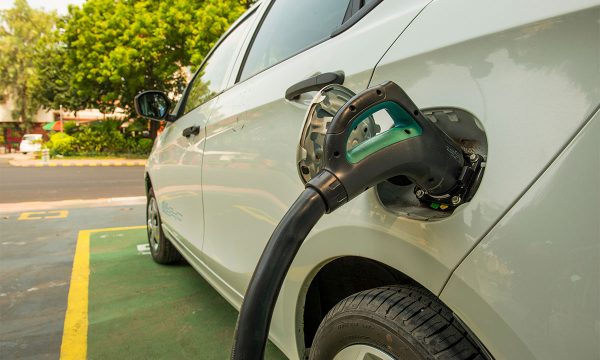
New York, New York, USA: 2022 Ford F-150 Lightning electric pickup truck at the New York Auto Show
Many forces are driving electric vehicle interest much higher. Is the industry ready?
I’ve always looked at the timeframe for the transition to electrified transportation through the lens of “it’s happening faster than the industry believes it will, but slower than many in the environmental community and government think it is going to.”
Well, now it seems that a week can’t go by without some major announcement in North America about a new electric vehicle production line, or a new battery plant, or a new complementary battery component facility being built.
The pace of investment in the new decarbonized automotive industry in Canada, North America, and around the world has been nothing short of dizzying.
In my 35 years in the Canadian industry, and essentially all of my life growing up in the industry, there has never been a time when as much money has been invested in Canada as there has been over the course of the last 18 months or so. The most significant investment is the $5 billion Stellantis/LG Energy Solutions Windsor battery plant, representing the largest single investment in Canadian automotive history.
Higher battery prices are doubly problematic when the market is just starting to see the introduction of electrified pickup trucks and SUVs in the market, which, because of their size and their capabilities, require larger batteries.
And while the transition to electrified transportation is happening fast—which is a challenge from a capacity perspective in and of itself—the unanticipated war in Ukraine, and three-decade-high levels of inflation across most of the globe, have only served to exacerbate the raw materials challenges for batteries.
This applies to both near term, and through to 2030, with a projected global shortage of almost 150 ktons of cobalt by 2030, demand for nickel increasing six times by 2030, also outstripping supply, and lithium demand increasing five times by 2030, outstripping supply for that metal as well.
In the short term, the International Energy Agency noted, in its report “Global EV Outlook 2022,” that in May of this year lithium prices were seven times higher than at the start of 2021, and the IEA also noted that Russia supplies 20 per cent of the global high-purity nickel, putting more stress and inflationary impact on an already stressed system.
So rather than continuing to “march down” the cost curve for batteries, the IEA contends that EV battery packs could become 15 per cent more expensive this year if prices for battery constituent materials remain elevated.
Higher battery prices are doubly problematic when the market is just starting to see the introduction of electrified pickup trucks and SUVs in the market, which, because of their size and their capabilities, require larger batteries.
While the IEA noted that the average battery capacity of BEVs was 55 kWh and 14 kWh for PHEV in 2021, Rivian’s pickup truck has 135 kWh battery pack, and the Ford Lightning pickup has a similar battery pack in its extended range offering, with standard range being almost 100 kWh. GM’s electric Hummer has a battery pack more than double that of the standard range Ford Lightning at 212 kWH!
Therefore, to the extent that 80 per cent of Canadians will still choose to drive an SUV or light-duty truck, if and when they purchase an EV, at the current battery price of around $132 kWh, that translates into batteries that comprise between $13,000 and almost $28,000 of the total cost of the vehicle, before any cost increase.
If we add the 15 per cent price premium resulting from battery component shortages and premiums, that adds another almost $2,000 to the cost of the battery at the low range, and $4,200 at the high range. In this context, it is easy to understand why some automakers either increased their EV prices, or tried to before reversing course in the face of public backlash.
Now this cost impact can be somewhat mitigated by the contracts that automakers have with their battery suppliers, however, the point is that EVs are not getting cheaper any time soon—especially in the light truck segments where the majority of Canadians purchase their vehicles.
McKinsey has suggested that to meet the projected global sale of EVs in 2030 (40 million, up from 6.5 million last year) the world will require another 200 gigafactories in addition to the 130 that are already in place. McKinsey also highlighted that these new gigafactories are not without their own challenges, from year long construction delays to ensuring the maximization of operational efficiency—which can make or break a new Gigafactory.
If we add to this constrained electrification model a significant uptick in consumer interest in EVs with the arrival of $2.00 plus/litre of gasoline, then it should be no real surprise to any consumer that the wait time for a number of EV models can be months or even into the next model year.
McKinsey has suggested that to meet the projected global sale of EVs in 2030 (40 million, up from 6.5 million last year) the world will require another 200 gigafactories in addition to the 130 that are already in place.
In some ways, the microchip shortage and other supply chain challenges that have constrained production and limited inventories at dealerships for ICE vehicles have assisted in conditioning customers to the idea that the process of purchasing a car of any sort, is not going down to the dealership, looking at dozens of the same model in different colours with slightly different equipment and trim levels until you find the one you like, and picking it up the next day.
The pandemic and subsequent supply chain challenges may in some ways permanently alter the way we buy any car in a way that is more consistent with how consumers have traditionally bought EVs—you put in an order and you wait.
I should add here, that a Zero Emission Vehicle Mandate isn’t going to get products to market any faster, so such a measure is not going to increase availability as some mandate proponents suggest.
Automakers are bringing on EV capacity as fast as they can, but the reality is, it takes time to build up a completely new automotive industry, with a completely new propulsion system, with its own supplier base. And it’s a supplier base that is focused on a number of critical and rare earth minerals for which we need to find a way to expeditiously get out of the ground, refine, process and integrate into battery packs.
These new vehicles are also going to be completely dependent on the electrical grid, and the growth and hardening of that to support that more than sixfold growth in annual sales of EVs by 2030. Will the grid be ready? It is an open question.
Finally, there is charging infrastructure. Neither the industry nor the planet can afford consumers having a bad experience with their EV purchase, such that they wish to revert back to a gasoline powered vehicle.
Whether consumers can charge their EV quickly, where they want to, and when they want to will be a large determinant of both consumer adoption and satisfaction with the EV experience.
It is estimated that Canada has about 16,000 chargers and the federal government has committed about $1.1 billion to install 50,000 chargers, however that target has not changed, even though the 2030 requirement ZEV sales of “at least 60 per cent” of all new car purchases by 2030 has increased, as a result of Canada’s Emissions Reduction Plan.
Even if Canadian sales stay lower than they have typically been over the last few years, and are around 1.5 million in 2030, that suggests that in 2030 alone there would be 900,000 EVs put onto the road.
Using a conservative global metric of one charging station for every 10 EVs, that suggests that we’d need at least 90,000 charging stations for just the EVs sold in 2030—not to mention all of the other EVs that will be sold between now and 2030, so our infrastructure ambition, and the price tag for that ambition, will be much higher and that investment needs to be made right now.
So while there is much excitement, and enthusiasm around the warp speed transition to electrified vehicles, if we don’t insert some patience and on-going assessment with respect to how all of the pieces of the puzzle are coming together—especially in the current economic context—we risk this transition being at best bumpy, and at worst coming off the rails.











